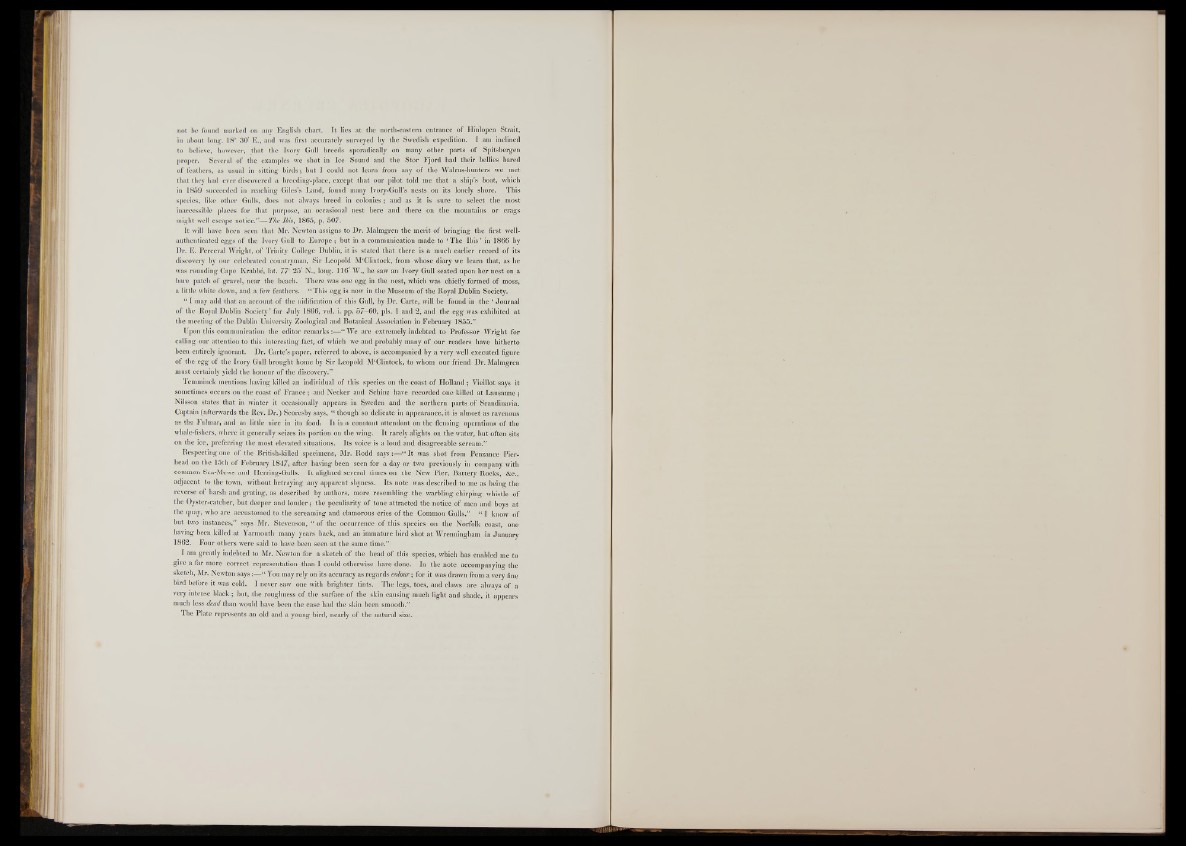
not be found marked on any English chart. It lies at the north-eastern entrance of Hinlopen Strait,
in about long. 18° 30' E., and was first accurately surveyed by the Swedish expedition. I am inclined
to believe, however, that the Ivory Gull breeds sporadically on many other parts o f Spitsbergen
proper. Several of the examples we shot in Ice Sound and the Stor Fjord had their bellies bared
of feathers, as usual in sitting birds; but I could not learn from any of the Walrus-hunters we met
that they had ever discovered a breeding-place, except that our pilot told me that a ship’s boat, which
in 1859 succeeded in reaching Giles’s Land, found many Ivory-Gull’s nests on its lonely shore. This
species, like other Gulls, does not always breed in colonies; and as it is sure to select the most
inaccessible places for that purpose, an occasional nest here and there on the mountains or crags
might well escape noticc."— Thc Ibis, 1865, p. 507.
It will have been seen that Mr. Newton assigns to Dr. Malmgren the merit o f bringing the first well-
authenticated eggs of the Ivory Gull to Europe ; but in a communication made to ‘The Ibis’ in 1866 by
Dr. E. Perceval Wright, o f Trinity College Dublin, it is stated that there is a much earlier record o f its
discovery by our celebrated countryman, Sir Leopold M'Clintock, from whose diary we learn that, as he
was rounding Cape Krabbe, lat. 77° 25' N., long. 116° W., he saw an Ivory Gull seated upon her nest on a
bare patch of gravel, near the beach. There was one egg in the nest, which was chiefly formed o f moss,
a little white down, and a few feathers. “ This egg is now in the Museum of the Royal Dublin Society.
“ I may add that an account of the nidification o f this Gull, by Dr. Carte, will be found in the ‘ Journal
o f the Royal Dublin Society ’ for July 1866, vol. i. pp. 5 7 -6 0 , pis. 1 and 2, and the egg was exhibited at
the meeting of the Dublin University Zoological and Botanical Association in February 1855.”
Upon this communication the editor remarks:— “ We are extremely indebted to Professor Wright for
calling our attention to this interesting fact, o f which we and probably many o f our readers have hitherto
been entirely ignorant. Dr. Carte’s paper, referred to above, is accompanied by a very well executed figure
o f the egg o f the Ivory Gull brought home by Sir Leopold M'Clintock, to whom our friend Dr. Malmgren
must certainly yield the honour of the discovery.”
Temminck mentions having killed an individual o f this species on the coast of Holland; Vieillot says it
sometimes occurs on the coast o f France; and Necker and Scbinz have recorded one killed at Lausanne ;
Nilsson states that in winter it occasionally appears in Sweden and the northern parts o f Scandinavia.
Captain (afterwards the Rev. Dr.) Scoresby says, “ though‘ so delicate in appearance, it is almost as ravenous
as the Fulmar, and as little nice in its food. It is a constant attendant on the flensing operations o f the
whale-fishers, where it generally seizes its portion on the wing. It rarely alights on the water, but often sits
on the ice, preferring the most elevated situations. Its voice is a loud and disagreeable scream.”
Respecting one o f the British-killed specimens, Mr. Rodd sa y s:—“ It was shot from Penzance Pierhead
on the 15th of February 1847, after having been seen for a day or two previously in company with
common Sea-Mews and Herring-Gulls. It alighted several times on the New Pier, Battery Rocks, &c.,
adjacent to the town, without betraying any apparent shyness. Its note was described to me as being the
reverse o f harsh and grating, as described by authors, more resembling the warbling chirping whistle of
the Oyster-catcher, but deeper and louder; the peculiarity o f tone attracted the notice o f men and boys at
the quay, who are accustomed to the screaming and clamorous cries of the Common Gulls.” ; “ I know of
but two instances,” says Mr. Stevenson, “ of the occurrence of this species on the Norfolk coast, one
having been killed at Yarmouth many years back, and an immature bird shot at Wrenningham in January
1862. Four others were said to have been seen at the same time.”
I am greatly indebted to Mr. Newton for a sketch o f the head o f this species, which has enabled me to
give a far more correct representation than I could otherwise have done. In the note accompanying the
sketch, Mr. Newton says:— “ You may rely on its accuracy as regards colour; for it was drawn from a very fine
bird before it was cold. I never saw one with brighter tints. The legs, toes, and claws are always o f a
very intense black ; but, the roughness o f the surface o f the skin causing much light and shade, it appears
much less dead than would have been the case had the skin been smooth.”
The Plate represents an old and a young bird, nearly of the natural size.